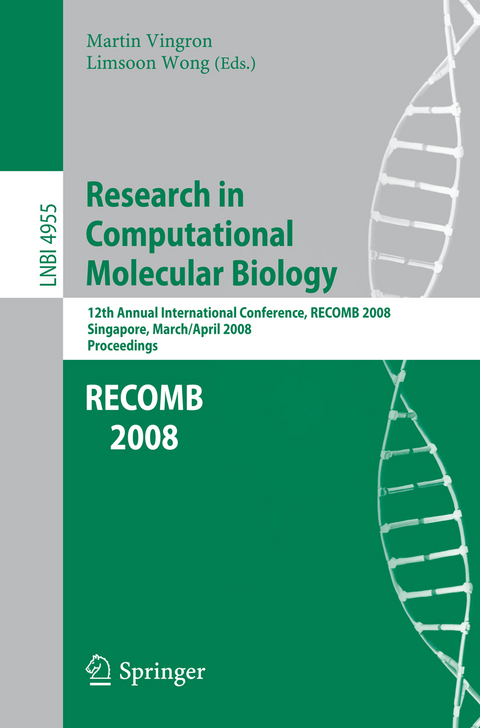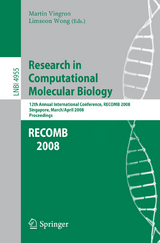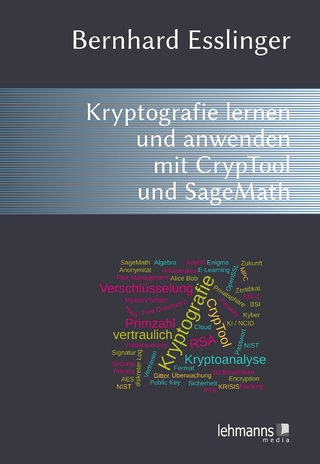Research in Computational Molecular Biology
Springer Berlin (Verlag)
978-3-540-78838-6 (ISBN)
This volume contains the papers presented at the 12th Annual International ConferenceonREsearchin COmputationalMolecularBiology(RECOMB2008) held in Singapore, March 30-April 2, 2008. The RECOMB conference series was founded in 1997 by Sorin Istrail, Pavel Pevzner and Michael Waterman. Its history is summarized in the table herein. The general development of the RECOMB conference series is guided by a Steering Committee. RECOMB 2008 was hosted by the National University of Singapore and held at the University Cultural Centre. The Conference Chair was Limsoon Wong, who was supported by a 16-member-strong Organizing Committee. Out of 193 papers submitted to RECOMB 2008, the Program Committee (PC) selected 34 papers for presentation at the conference. The PC consisted of 46 members, who could further draw on the help of subreviewers. Three PC members with possible help of the external reviewers ?rst reviewed each paper, subsequently a Web-based discussion led to the ?nal selection of papers. This year, RECOMB and the journal Genome Research teamed up to - fer authors Genome Research as an alternative forum for publication. Appro- mately 55 of the RECOMB submissions, selected by a subset of the PC headed by Sera?m Batzoglou, were forwarded to Genome Research for consideration.
Computational Biology: Its Challenges Past, Present, and Future.- Bootstrapping the Interactome: Unsupervised Identification of Protein Complexes in Yeast.- CompostBin: A DNA Composition-Based Algorithm for Binning Environmental Shotgun Reads.- Reconstructing the Evolutionary History of Complex Human Gene Clusters.- Ab Initio Whole Genome Shotgun Assembly with Mated Short Reads.- Orchestration of DNA Methylation.- BayCis: A Bayesian Hierarchical HMM for Cis-Regulatory Module Decoding in Metazoan Genomes.- A Combined Expression-Interaction Model for Inferring the Temporal Activity of Transcription Factors.- A Fast, Alignment-Free, Conservation-Based Method for Transcription Factor Binding Site Discovery.- The Statistical Power of Phylogenetic Motif Models.- Transcriptional Regulation and Cancer Genomics.- Automatic Recognition of Cells (ARC) for 3D Images of C. elegans.- Spectrum Fusion: Using Multiple Mass Spectra for De Novo Peptide Sequencing.- A Fragmentation Event Model for Peptide Identification by Mass Spectrometry.- A Bayesian Approach to Protein Inference Problem in Shotgun Proteomics.- De Novo Sequencing of Nonribosomal Peptides.- Systems Metabolic Engineering.- Protein Function Prediction Based on Patterns in Biological Networks.- Automatic Parameter Learning for Multiple Network Alignment.- An Integrative Network Approach to Map the Transcriptome to the Phenome.- Fast and Accurate Alignment of Multiple Protein Networks.- High-Resolution Modeling of Cellular Signaling Networks.- At the Origin of Life: How Did Folded Proteins Evolve?.- Locating Multiple Gene Duplications through Reconciled Trees.- Rapid and Accurate Protein Side Chain Prediction with Local Backbone Information.- Algorithms for Joint Optimization of Stability and Diversity in Planning Combinatorial Libraries of Chimeric Proteins.- DLIGHT - Lateral Gene Transfer Detection Using Pairwise Evolutionary Distances in a Statistical Framework.- Computation of Median Gene Clusters.- BCL-2: From Translocation to Therapy.- Detecting Disease-Specific Dysregulated Pathways Via Analysis of Clinical Expression Profiles.- Constructing Treatment Portfolios Using Affinity Propagation.- Bubbles: Alternative Splicing Events of Arbitrary Dimension in Splicing Graphs.- More Efficient Algorithms for Closest String and Substring Problems.- Disruption of a Transcriptional Regulatory Pathway Contributes to Phenotypes in Carriers of Ataxia Telangiectasia.- Accounting for Non-genetic Factors Improves the Power of eQTL Studies.- Effects of Genetic Divergence in Identifying Ancestral Origin Using HAPAA.- On the Inference of Ancestries in Admixed Populations.- Increasing Power in Association Studies by Using Linkage Disequilibrium Structure and Molecular Function as Prior Information.- Panel Construction for Mapping in Admixed Populations Via Expected Mutual Information.- Constructing Level-2 Phylogenetic Networks from Triplets.- Accurate Computation of Likelihoods in the Coalescent with Recombination Via Parsimony.
| Erscheint lt. Verlag | 14.3.2008 |
|---|---|
| Reihe/Serie | Lecture Notes in Bioinformatics | Lecture Notes in Computer Science |
| Zusatzinfo | XVI, 480 p. |
| Verlagsort | Berlin |
| Sprache | englisch |
| Maße | 155 x 235 mm |
| Gewicht | 759 g |
| Themenwelt | Informatik ► Theorie / Studium ► Algorithmen |
| Mathematik / Informatik ► Mathematik ► Wahrscheinlichkeit / Kombinatorik | |
| Schlagworte | algorithm • Algorithm analysis and problem complexity • algorithms • Bioinformatics • comparative genomics • Computational Biology • computational proteomics • comutational molecular biology • data structures • DNA composition metrics • DNA sequence motifs • feature extraction • gene transfer • Genome • genome data analysis • genome signatures • graph theory • Hardcover, Softcover / Informatik, EDV/Informatik • HC/Informatik, EDV/Informatik • machine learning • Metagenomics • microarray data analysis • Optimization • origin of life • Pattern Matching • probabilistic methods • protein fold recognition • protein interaction networks • Protein Structure Prediction • Proteomics • Sequence Analysis • sequencing technologies • Similarity Search • Support Vector Machines |
| ISBN-10 | 3-540-78838-7 / 3540788387 |
| ISBN-13 | 978-3-540-78838-6 / 9783540788386 |
| Zustand | Neuware |
| Informationen gemäß Produktsicherheitsverordnung (GPSR) | |
| Haben Sie eine Frage zum Produkt? |
aus dem Bereich




